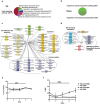Mitochondrial dysfunction-associated microbiota establishes a transmissible refractory response to anti-TNF therapy during ulcerative colitis
- PMID: 37842919
- PMCID: PMC10586225
- DOI: 10.1080/19490976.2023.2266626
Mitochondrial dysfunction-associated microbiota establishes a transmissible refractory response to anti-TNF therapy during ulcerative colitis
Abstract
Anti-TNF therapy can induce and maintain a remission status during intestinal bowel disease. However, up to 30% of patients do not respond to this therapy by mechanisms that are unknown. Here, we show that the absence of MCJ, a natural inhibitor of the respiratory chain Complex I, induces gut microbiota changes that are critical determinants of the lack of response in a murine model of DSS-induced inflammation. First, we found that MCJ expression is restricted to macrophages in human colonic tissue. Therefore, we demonstrate by transcriptomic analysis of colon macrophages from DSS-induced mice that MCJ-deficiency is linked to the expression of genes belonging to the FcγR signaling pathway and contains an anti-TNF refractory gene signature identified in ulcerative colitis patients. The gut microbial composition changes observed upon DSS treatment in the MCJ-deficient mice revealed the increased presence of specific colitogenic members, including Ruminococcus gnavus and Oscillospira, which could be associated with the non-response to TNF inhibitors. Further, we show that the presence of a microbiota associated resistance to treatment is dominant and transmissible to responsive individuals. Collectively, our findings underscore the critical role played by macrophage mitochondrial function in the gut ecological niche that can substantially affect not only the severity of inflammation but also the ability to successfully respond to current therapies.
Keywords: FcγR signaling; IBD; anti-TNF therapy; complex I; microbiota; mitochondriopathy.
Conflict of interest statement
No potential conflict of interest was reported by the author(s).
Figures






Similar articles
-
Spirulina platensis aqueous extracts ameliorate colonic mucosal damage and modulate gut microbiota disorder in mice with ulcerative colitis by inhibiting inflammation and oxidative stress.J Zhejiang Univ Sci B. 2022 Jun 15;23(6):481-501. doi: 10.1631/jzus.B2100988. J Zhejiang Univ Sci B. 2022. PMID: 35686527 Free PMC article.
-
Berberine Depresses Inflammation and Adjusts Smooth Muscle to Ameliorate Ulcerative Colitis of Cats by Regulating Gut Microbiota.Microbiol Spectr. 2022 Dec 21;10(6):e0320722. doi: 10.1128/spectrum.03207-22. Epub 2022 Oct 26. Microbiol Spectr. 2022. PMID: 36287004 Free PMC article.
-
Anti-tumor necrosis factor α therapy associates to type 17 helper T lymphocytes immunological shift and significant microbial changes in dextran sodium sulphate colitis.World J Gastroenterol. 2019 Mar 28;25(12):1465-1477. doi: 10.3748/wjg.v25.i12.1465. World J Gastroenterol. 2019. PMID: 30948910 Free PMC article.
-
Supplementation With Chinese Medicinal Plant Extracts From Lonicera hypoglauca and Scutellaria baicalensis Mitigates Colonic Inflammation by Regulating Oxidative Stress and Gut Microbiota in a Colitis Mouse Model.Front Cell Infect Microbiol. 2022 Jan 4;11:798052. doi: 10.3389/fcimb.2021.798052. eCollection 2021. Front Cell Infect Microbiol. 2022. PMID: 35059326 Free PMC article.
-
Protopine Alleviates Dextran Sodium Sulfate-Induced Ulcerative Colitis by Improving Intestinal Barrier Function and Regulating Intestinal Microbiota.Molecules. 2023 Jul 7;28(13):5277. doi: 10.3390/molecules28135277. Molecules. 2023. PMID: 37446938 Free PMC article.
Cited by
-
Cellular and Molecular Determinants of Biologic Drugs Resistance and Therapeutic Failure in Inflammatory Bowel Disease.Int J Mol Sci. 2024 Feb 28;25(5):2789. doi: 10.3390/ijms25052789. Int J Mol Sci. 2024. PMID: 38474034 Free PMC article. Review.
-
Stress triggers gut dysbiosis via CRH-CRHR1-mitochondria pathway.NPJ Biofilms Microbiomes. 2024 Sep 30;10(1):93. doi: 10.1038/s41522-024-00571-z. NPJ Biofilms Microbiomes. 2024. PMID: 39349483 Free PMC article.
-
Integrated analysis and single-cell sequencing of mitochondrial metabolism related gene molecular subtype and diagnostic model in ulcerative colitis.PLoS One. 2025 Mar 28;20(3):e0320010. doi: 10.1371/journal.pone.0320010. eCollection 2025. PLoS One. 2025. PMID: 40153427 Free PMC article.
-
Mitophagy and immune cell interaction: insights into pathogenesis and potential targets for necrotizing enterocolitis.Transl Pediatr. 2025 Feb 28;14(2):171-186. doi: 10.21037/tp-24-441. Epub 2025 Feb 25. Transl Pediatr. 2025. PMID: 40115463 Free PMC article.
-
Disrupted mitochondrial morphology and function exacerbate inflammation in elderly-onset ulcerative colitis.Immun Ageing. 2025 Jan 10;22(1):4. doi: 10.1186/s12979-024-00494-5. Immun Ageing. 2025. PMID: 39794776 Free PMC article.
References
-
- Gerriets V, Goyal A, Khaddour K. Tumor necrosis factor inhibitors. Florida: StatPearls. Treasure Island (FL); 2022. - PubMed
-
- Haberman Y, Karns R, Dexheimer PJ, Schirmer M, Somekh J, Jurickova I, Braun T, Novak E, Bauman L, Collins MH, et al. Ulcerative colitis mucosal transcriptomes reveal mitochondriopathy and personalized mechanisms underlying disease severity and treatment response. Nat Commun. 2019;10(1):38. doi:10.1038/s41467-018-07841-3. - DOI - PMC - PubMed
Publication types
MeSH terms
Substances
LinkOut - more resources
Full Text Sources
Medical
Molecular Biology Databases
